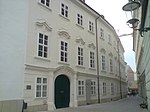Jesuit Church, Bratislava
17th-century Roman Catholic church buildings in SlovakiaJesuit churches in SlovakiaRoman Catholic churches in BratislavaSlovak church stubs

The Holy Saviour Church (Slovak: Kostol Najsvätejšieho Spasiteľa, Jezuitský kostol) also called the Jesuit Church, is an originally protestant church from the 17th century on the Franciscan Square in the Old Town of Bratislava, Slovakia. Today, the church belongs to the Society of Jesus, known as the Jesuit Order.
Excerpt from the Wikipedia article Jesuit Church, Bratislava (License: CC BY-SA 3.0, Authors, Images).Jesuit Church, Bratislava
Františkánske námestie, Bratislava Bratislava (District of Bratislava I)
Geographical coordinates (GPS) Address External links Nearby Places Show on map
Geographical coordinates (GPS)
| Latitude | Longitude |
|---|---|
| N 48.143888888889 ° | E 17.108611111111 ° |
Address
Kostol Najsvätejšieho Spasiteľa (Jezuitský kostol)
Františkánske námestie 1410/5
811 01 Bratislava, Bratislava (District of Bratislava I)
Region of Bratislava, Slovakia
Open on Google Maps









